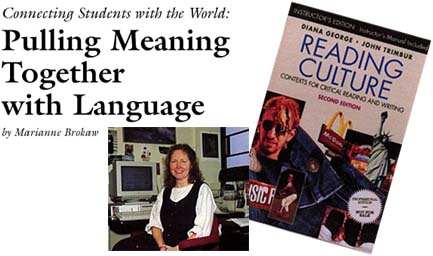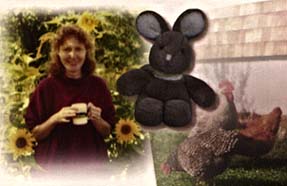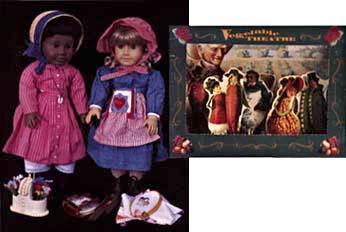![]()
 Diana
George sits surrounded by the usual professorial shelves of books and piles
of professional journals, stacks of materials, read and unread. But in this
office, images paper the walls: postcards, signs, photographs, posters,
cartoons-a Degas poster side by side with a photo of Maggie, her golden
retriever. Diana points out her favorites: a black-and-white postcard of
a dancer, leg extended, perched precariously on a rock overhanging a cliff-"Some
days this feels like my life"; a photograph of a window sill
lined with fruit-filled canning jars-"This is my life."
Diana
George sits surrounded by the usual professorial shelves of books and piles
of professional journals, stacks of materials, read and unread. But in this
office, images paper the walls: postcards, signs, photographs, posters,
cartoons-a Degas poster side by side with a photo of Maggie, her golden
retriever. Diana points out her favorites: a black-and-white postcard of
a dancer, leg extended, perched precariously on a rock overhanging a cliff-"Some
days this feels like my life"; a photograph of a window sill
lined with fruit-filled canning jars-"This is my life."
George chuckles at a 1950s postcard showing happy elementary school children crouching under their tiny desks, "Remember 'duck and cover'?"
Her walls and nooks are a smorgasbord of the good, the bad, and the silly. Perched on a shelf (amongst a fuzzy rabbit, children's blocks, and a Grapenuts® cereal box) is a 3-D cardboard setup called the Vegetable Theater, complete with carrot, peas, and corn puppets-in costume.
"Don't even ask," she laughs.
At Michigan Tech where research is often about the unspellable and unpronounceable, Diana George's scholarship seems strangely simple. "I have to admit that most of my research is about what surrounds us. I'm fascinated by popular culture." Unlike most of us, George actually admits to watching lots of movies and television. "And what's worse is that I'm often rewinding and watching again."
She studies what popular culture tells us about ourselves, reading the patterns of meaning in what surrounds us. An associate professor of cultural theory and composition studies in the humanities department, she not only watches television, but reads textbooks, historiography, and journals, and studies post-colonial theory. The ability to tease out meaning from the coming together of these sources is the crux of her work. While some would describe popular culture as being good or bad, depending on your generational point of view, George sees it as a "knowledge system and a place where we form ideas."
George's scholarship is published in numerous academic journals and it also goes directly into the classroom via a best-selling text, Reading Culture. Co-authored by Diana George and colleague John Trimbur, the book is being published in its third edition at HarperCollins, with more than 35,000 copies sold.
Book editor Patricia Rossi says instructors love Reading Culture because it is written by teachers who are also scholars. Adopted in schools as diverse as Salt Lake City Community College and the University of Michigan, George says reviews of the book were unusual because the reviewers focused more on student reaction than on teacher reaction.
 Students like it.
Students like it.
Unlike traditional texts that often had students reading literature and writing about what they like to call "hidden meaning," these essays are about topics students recognize-television, style, music, mall life, education, image. "They can enter the discussion," George says, believing students need to have something to say, not just something to report.
Students tend to believe that they can't write, that only a chosen few have the key. What they wrote about in the classroom stayed in the classroom with English teachers; it was not connected to their world. George says students can leave the classroom talking about writing instead of hidden meaning, understanding that "writing is about pulling meaning together with language, giving them access to the part that helps them act." George wants them to be conscious of themselves as language users whose writing has a purpose and an audience that exists outside the classroom.
Beyond using popular culture as subject matter for compositions, George has loftier ambitions for students: "I don't want clever cultural critics."
She believes we aren't born with attitudes like nationalism, racism, materialism, but that we learn them through our cultural upbringing, an upbringing that has been altered by the influence of mass-mediated communication, changing the way we learn our stories about ourselves. "More and more, our stories come to us not from ancestors so much and not as original stories, but often come to us mediated, via a commercial system."
That system is going to change the stories we hear. These stories, according to George, tell us about what it means to be successful, attractive, or accepted. We learn what to think about other values, cultures, and people.
Students are very comfortable with mass media, but they claim they aren't influenced; it's the background of their lives. George notes, however, that though students might be savvy to the hidden meaning in advertising, they are often unaware about how that meaning manifests itself in their daily lives.
She questions how they decide, for example, which jeans fit the best.
"Even though my students say they choose the jeans that fit the best, five years ago they were telling me Guess? jeans fit the best, and, periodically, they will say that Levi's fit the best. But I don't think it's a coincidence that right now when Calvin Klein ads are hot and controversial, students say they wear Calvin jeans because they fit the best."
Though that might not seem a serious message in and of itself, George tries to teach students that we are all always receiving messages. "And we can't receive without also being a part of the message."
Discussing Klein ads may seem trivial at a university where acquiring practical employment skills and a profession is of utmost importance, but the discussion is really about much more than consumer choices. The discussion is about a culture that constantly and often aggressively surrounds us.
Students must often be convinced to seriously think about popular culture. "I'm going to be an engineer; I'm not going into social work." But when recruiters tell MTU they want people who can think, who are not followers, who can work in an international marketplace, they acknowledge the need for critical reflection.
George wants her students to leave the classroom with "some little itch in the back of their head that says, 'Well now is that the whole story? Are there some other ways to see this?'"
In her view, raising the consciousness of people is vital to real understanding. "Until we're conscious of what we do, we haven't really learned much about it. We don't make choices very easily if we're not conscious. Once you make students more conscious of what's around them, we have more of a chance of talking to them about difference and how important difference is, rather than sameness."
Making students aware of difference can be a challenging job at Michigan Tech, where a majority of the population is white, male, and majoring in engineering.
"At other universities, diversity is in your face," says graduate student and teaching assistant Nancy Barron from Los Angeles. "Campuses are close to each other; neighborhoods are around you. Students know each other from other campuses and disciplines. You can drive thirty-five minutes and see overwhelming pockets of poverty." Discussion between groups is possible. But in Houghton, the differences are often hidden or spread out.
Barron found it hard at first to present a multicultural view in the classroom. "Students need to experience it. When I ask students where poverty is or where black communities are, they say, 'Detroit.' They also quickly say that they don't go there." Reading Culture helps Barron's students discuss "the reality that exists; things that aren't fun to talk about, that pull on your consciousness."
Understanding and facing the reality creating our culture seems to be the key. George maintains that "the whole idea is that culture is ordinary, but the ordinary is absolutely important to our material and spiritual lives." For George, the goal is not to make students leave the classroom with her politics, but with the knowledge that there is more than one politics.
Her current research questions "the way history is taught and has been taught." While schools move toward adopting a more-open history curricula, a facet of George's research looks at what it means, for example, when a company that sells dolls also starts manufacturing history curricula for the public schools.
 The Pleasant Company sells
expensive collector dolls in The American Doll Collection that illustrate
periods in American history-one is Addie, the African-American, post-Civil
War doll; another is Felicity, a colonial doll; a third is Kirsten, an immigrant
doll. If a school system buys The Pleasant Company's curriculum, it can
also rent the dolls and put them in front of the class for the children
to look at while the teacher reads about this period in history. Noting
that the Pleasant Company sells their take on history along with their dolls,
George knows "there is something interesting about that connection
of toy, history, reading stories, schooling, and putting dolls up there
for the children to want them."
The Pleasant Company sells
expensive collector dolls in The American Doll Collection that illustrate
periods in American history-one is Addie, the African-American, post-Civil
War doll; another is Felicity, a colonial doll; a third is Kirsten, an immigrant
doll. If a school system buys The Pleasant Company's curriculum, it can
also rent the dolls and put them in front of the class for the children
to look at while the teacher reads about this period in history. Noting
that the Pleasant Company sells their take on history along with their dolls,
George knows "there is something interesting about that connection
of toy, history, reading stories, schooling, and putting dolls up there
for the children to want them."
Connecting the ordinary to extraordinary ideas is delicate work, work that sometimes confounds and eludes analysis, but work that brings the world we inhabit into MTU classrooms.
![]()